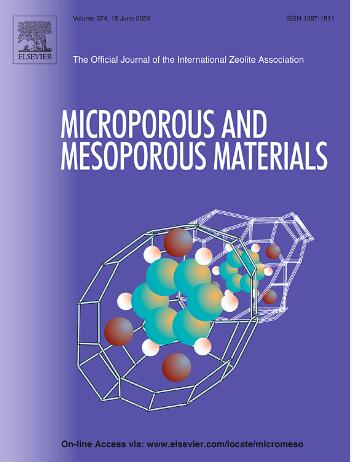Aluminophosphates and Silicoaluminophosphates Zeolites tailored by different Imidazolium Cations and their evaluation as catalysts for CO2-Epoxide Cycloaddition
IF 4.8
3区 材料科学
Q1 CHEMISTRY, APPLIED
引用次数: 0
Abstract
In this work, we study the structure-directing effect of three different cations based on 1,2-dimethylimidazolium moieties linked by a linear bridge of n = 3, 4 or 5 methylene groups (3BDMI, 4BDMI, and 5BDMI, respectively), for the synthesis of silicoaluminophosphate and aluminophosphate microporous molecular sieves. These cations allowed the crystallization of three different structures (AFI, SFO and SAS), presenting different specificity for these phases. They all yielded zeolite AFI, which is considered a default structure; nevertheless, 3BDMI and 4BDMI cations (in AlPO and SAPO compositions) tend to favor the crystallization of PST-27, a monoclinic version of the AFI structure. The crystallization of the SAS and SFO phases depended on the mineralizing agents (fluoride or hydroxide), and was only afforded in SAPO composition; when the synthesis was carried out in hydroxide medium, the three OSDA induced the crystallization of the SAS framework. In contrast, the SFO zeolite was yielded under fluoride medium, and only with 3BDMI and 4BDMI cations. In an attempt to understand the structure-directing behavior of these cations, molecular simulations were carried out to study the locations and conformations of the dications in each of these frameworks. In the case of SAS, cavities were filled with two imidazolium rings of consecutive cations, which site stacked to each other stabilized through π···π interactions between imidazolium rings. In the SFO framework, the organic dications arranged in a zig-zag like conformation, siting their imidazolium rings in consecutive lateral side-pockets. On the other hand, the materials obtained were applied as catalysts for the cycloaddition of CO2 in epoxide reactions, exhibiting interesting catalytic activities.

求助全文
约1分钟内获得全文
求助全文
来源期刊

Microporous and Mesoporous Materials
化学-材料科学:综合
CiteScore
10.70
自引率
5.80%
发文量
649
审稿时长
26 days
期刊介绍:
Microporous and Mesoporous Materials covers novel and significant aspects of porous solids classified as either microporous (pore size up to 2 nm) or mesoporous (pore size 2 to 50 nm). The porosity should have a specific impact on the material properties or application. Typical examples are zeolites and zeolite-like materials, pillared materials, clathrasils and clathrates, carbon molecular sieves, ordered mesoporous materials, organic/inorganic porous hybrid materials, or porous metal oxides. Both natural and synthetic porous materials are within the scope of the journal.
Topics which are particularly of interest include:
All aspects of natural microporous and mesoporous solids
The synthesis of crystalline or amorphous porous materials
The physico-chemical characterization of microporous and mesoporous solids, especially spectroscopic and microscopic
The modification of microporous and mesoporous solids, for example by ion exchange or solid-state reactions
All topics related to diffusion of mobile species in the pores of microporous and mesoporous materials
Adsorption (and other separation techniques) using microporous or mesoporous adsorbents
Catalysis by microporous and mesoporous materials
Host/guest interactions
Theoretical chemistry and modelling of host/guest interactions
All topics related to the application of microporous and mesoporous materials in industrial catalysis, separation technology, environmental protection, electrochemistry, membranes, sensors, optical devices, etc.
 求助内容:
求助内容: 应助结果提醒方式:
应助结果提醒方式:


